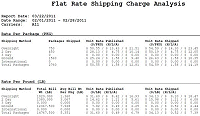
Forecasts say that online sales will grow again in 2011, even in our current economy. If you do business online, will you get your share? Eliminating as much cart abandonment as possible can definitely help. As you plan your online sales strategy, your shipping system can give you the information you need to make your final pricing right for your customers.
For your customers (and potential customers!), do you charge different amounts for shipping depending on the package destination? If so, your price is different for the same item, depending on where your customer lives. When you visit any local store, do they ask for your ZIP code before you get the price? OK, maybe that’s a bit of a stretch, but no one is happy to know they are paying more than someone else for the same item. And shipping “sticker shock” is a documented factor that creates abandoned shopping carts.
What strategy can solve this? A number of experts and Internet entrepreneurs report it is very important to display shipping charges before check out to avoid shopping cart abandonment. Flat rate shipping strategically mixed with "free" shipping offers can successfully attack this problem. Now, how to do this?
Of course, free shipping is very easy to calculate. Determining the right flat-rate shipping charge takes a little more effort. The easiest way is to use your actual carrier rates in your shipping system, then use historical reporting directly from the shipping system. As an example, the CPS shipping software, using your actual carrier rates, provides its FLAT RATE SHIPPING CHARGE ANALYSIS report:

This report shows average shipping cost per package and average shipping cost per pound. Choose all the carriers you use or specific carriers. These costs are also displayed by service - next day, 2 day, 3 day, ground and international services. With just a few mouse clicks you can keep tabs on your shipping costs for any period of time by carrier and service. Use this information to accurately manage your flat rate shipping cost offers and your “break even” point to stop shipping cost shock and reduce abandoned carts.
You might be able to get these same numbers from your carrier bills, but carrier invoices I’ve seen are very far from “user friendly”. When you need critical information right now, it’s so much easier to just "Click" and get what you need in seconds. This example describes Harvey Software’s CPS shipping system, but you may find similar reporting in your shipping system.
You should monitor costs at least monthly so you can make adjustments if needed. One popular marketing/sales technique is to use flat rate charges as your standard shipping price, then offer free shipping for special times of the year like holidays when competition is very hot for consumer dollars.
Use these tips so your shoppers from across the country click "Buy" instead of "Bye".
For more information about CPS, visit http://www.harveysoft.com/.


